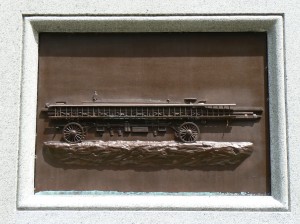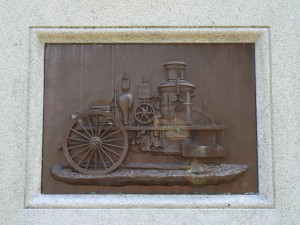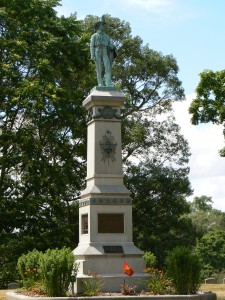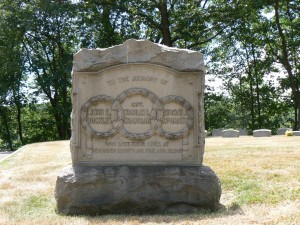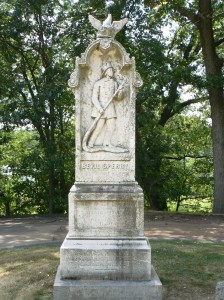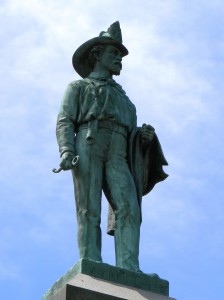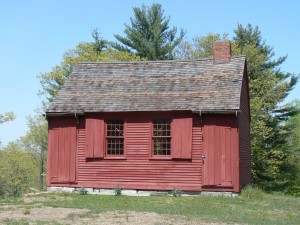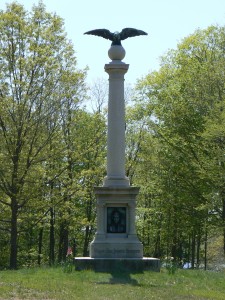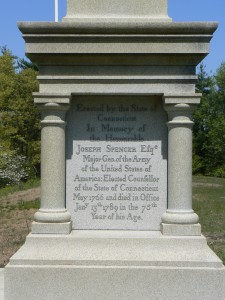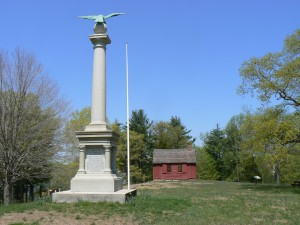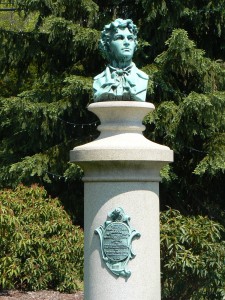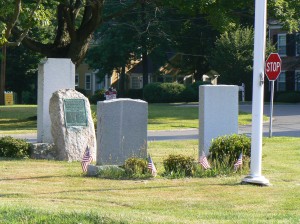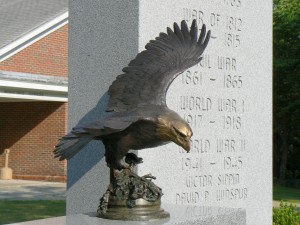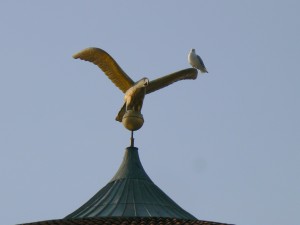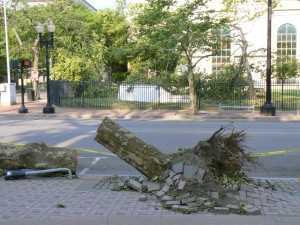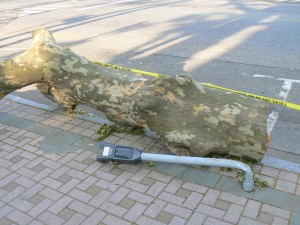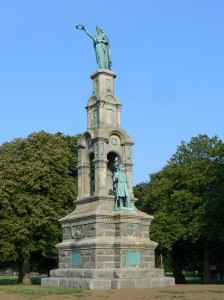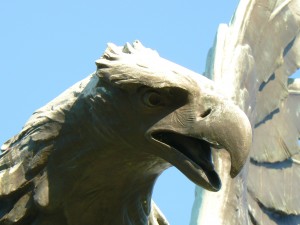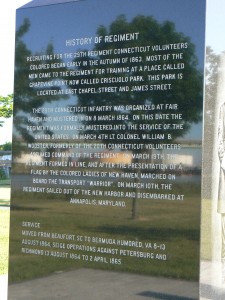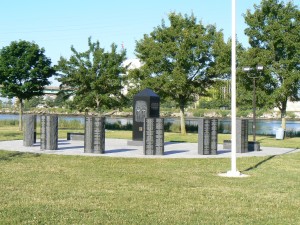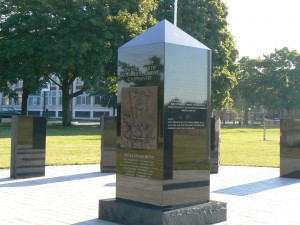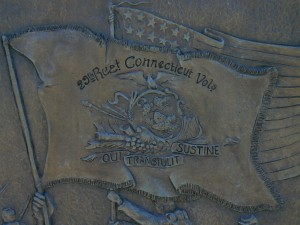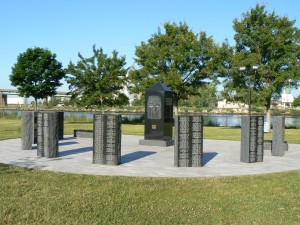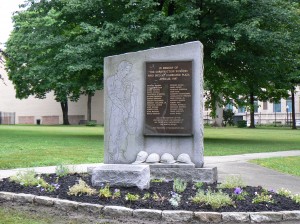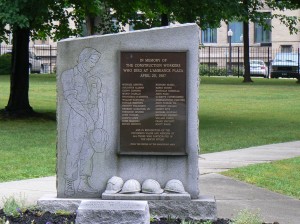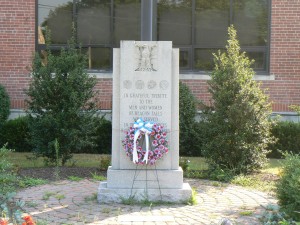 Beacon Falls honors its military veterans with a monument on the grounds of Town Hall.
Beacon Falls honors its military veterans with a monument on the grounds of Town Hall.
The Beacon Falls Veterans Monument, on Maple Street near the corner of Burton Road, stands outside the town’s municipal building.
The undated granite monument, sponsored by the local Lions Club and American Legion post, bears a dedication on its front (southwest) face reading, “In grateful tribute to the men and women of Beacon Falls who served in the armed forces during national crises.”
The monument also features an engraved eagle as well as the logos of the four major military service branches.
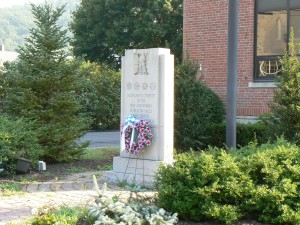 The monument stands in the middle of a small circular plaza, surrounded by decorative shrubbery.
The monument stands in the middle of a small circular plaza, surrounded by decorative shrubbery.
Tags: Beacon Falls
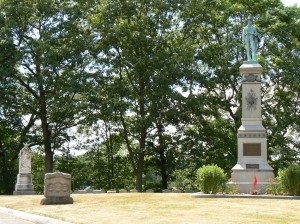 New Haven honors its firefighters with a monument and burial plot in the city’s Evergreen Cemetery.
New Haven honors its firefighters with a monument and burial plot in the city’s Evergreen Cemetery.
A dedication plaque on the front (east) face of the 1877 Firemen’s Monument reads, “Erected to the memory of the firefighters of the city of New Haven by the Firemen’s Benevolent Association.”
The east face also features plaque commemorating the monument’s 1993 rededication, as well as a decorative trophy depicting the department’s logo, crossed ladders and a variety of firefighting tools. The city’s emblem also appears near the top of the monument’s east face.
The monument’s north, west and south faces feature bronze plaques with ornate depictions of antique (to our eyes) firefighting vehicles and equipment.
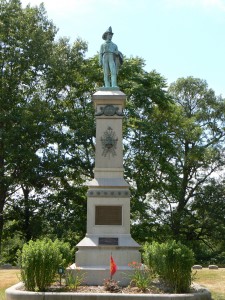 The monument is topped by a helmeted bronze firefighter, standing with a wrench in his right hand and a coat draped over his left arm. The firefighter was sculpted by Melzar Mosman, whose other Connecticut works include monuments in Middletown and Danielson, as well as the figures on the Civil War monuments in Bridgeport’s Seaside Park. (The firefighter’s monument design, with a figure atop a column decorated with a trophy, is very similar to an 1870 Civil War monument.)
The monument is topped by a helmeted bronze firefighter, standing with a wrench in his right hand and a coat draped over his left arm. The firefighter was sculpted by Melzar Mosman, whose other Connecticut works include monuments in Middletown and Danielson, as well as the figures on the Civil War monuments in Bridgeport’s Seaside Park. (The firefighter’s monument design, with a figure atop a column decorated with a trophy, is very similar to an 1870 Civil War monument.)
Next to the large monument is a smaller monument honoring three of the six firefighters who were killed in April of 1910 battling a fire at the former New Haven County jail on Whalley Avenue.
In the southwest corner of the firemen’s plot is an 1852 marble monument honoring Bevil Sperry, who was killed fighting a grocery store fire on State Street. Sperry was the first of 59 New Haven firefighters who fall in the line of the duty, and the first firefighter interred in the then-new plot.
The Sperry monument was created by Thomas Phillips, one of the founders of Evergreen Cemetery and a firm that would become New Haven’s most prominent supplier of cemetery and public memorials.
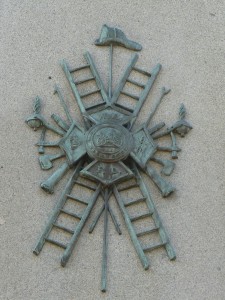 Evergreen Cemetery also features the 1870 monument to the 204 Civil War soldiers who died in New Haven’s Knight Hospital from their wartime wounds.
Evergreen Cemetery also features the 1870 monument to the 204 Civil War soldiers who died in New Haven’s Knight Hospital from their wartime wounds.
Tags: Firefighters, New Haven
 A recently restored powder house in Fairfield was built in 1814 to help the town defend itself against possible British invasion during the War of 1812.
A recently restored powder house in Fairfield was built in 1814 to help the town defend itself against possible British invasion during the War of 1812.
The powder house, which stands behind Tomlinson Middle School on Fairfield’s Unquowa Road, is believed to be the only remaining example in Connecticut of numerous such buildings used to store gunpowder and ammunition during the country’s early history.
The bronze plaque next to the powder house’s door was added during a 1924 restoration, and provides information about the 1814 town meeting at which residents approved the powder house construction. During that restoration, a slate roof was added and the site was surrounded by a stone wall.
 The local Daughters of the American Revolution chapter was honored by the national organization for a 2009 restoration project that gave the powder house a new wooden roof and door, and a new bench in front of the building.
The local Daughters of the American Revolution chapter was honored by the national organization for a 2009 restoration project that gave the powder house a new wooden roof and door, and a new bench in front of the building.
Opening the powder house’s new wooden door reveals a dark, moist interior inhabited by what appeared to be thousands of camel crickets, frighteningly large insects also known as spider crickets due to their large legs. The crickets provided an effective disincentive against further exploration of the building’s interior.
The vintage postcard bears a 1909 postmark, and shows the powder house before the slate roof and exterior plaque were added. The caption incorrectly attributes the building to 1812.
Tags: Fairfield
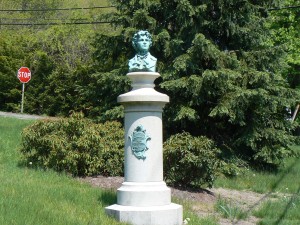 Nathan Hale’s brief tenure as an East Haddam schoolmaster is honored with a local monument as well as the schoolhouse in which he taught.
Nathan Hale’s brief tenure as an East Haddam schoolmaster is honored with a local monument as well as the schoolhouse in which he taught.
The Nathan Hale bust, dedicated in 1905, stands in the original location of the schoolhouse in what is now a small triangular park at the intersection of Main Street (Route 149) and Norwich Road (Route 82) in East Haddam.
The bust stands atop a granite column that bears a plaque reading, “On this site stood the schoolhouse in which Nathan Hale first taught during the winter of 1773-4. Erected by the Nathan Hale Memorial Chapter, Daughters of the American Revolution, East Haddam, Conn., 1905.” The plaque also bears an image of the schoolhouse.
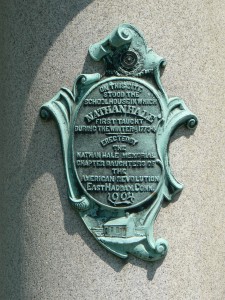 The bust was created by sculptor Enoch Smith Woods, who also produced a statue of Hale that stands outside the Wadsworth Atheneum in Hartford, as well as a statue of American Revolution hero Thomas Knowlton on the state capitol grounds.
The bust was created by sculptor Enoch Smith Woods, who also produced a statue of Hale that stands outside the Wadsworth Atheneum in Hartford, as well as a statue of American Revolution hero Thomas Knowlton on the state capitol grounds.
The restored schoolhouse in which Hale taught stands less than a quarter mile north of the bust, on a hilltop overlooking Main Street’s River View Cemetery. The schoolhouse was moved to its current location and rededicated in June of 1900 as part of ceremonies honoring the bicentennial of East Haddam’s separation from Haddam.
The building operated as a school from its 1750 construction until 1799, when it was moved and converted into a private residence. In 1899, it was moved again to its present location and rededicated as a museum.
Hale’s assignment in East Haddam was his first job after graduating from Yale. Five months after arriving in East Haddam, he left to begin teaching in New London, where he is honored with a statue and a preserved schoolhouse that also moved several times before reaching its current downtown location.
 The schoolhouse site, maintained by the Connecticut Society of the Sons of the American Revolution, also features a monument to Maj. Gen. Joseph Spencer, who commanded Continental troops fighting in Rhode Island during the early stages of the revolution.
The schoolhouse site, maintained by the Connecticut Society of the Sons of the American Revolution, also features a monument to Maj. Gen. Joseph Spencer, who commanded Continental troops fighting in Rhode Island during the early stages of the revolution.
The monument, a granite column topped by a bronze eagle, features a bronze portrait of Spencer on its northern face. The monument’s southern face includes a dedication reading, “Erected by the state of Connecticut in memory of the honorable Joseph Spencer, Esq., Major Gen. of the Army of the United States of America; elected counselor of the state of Connecticut 1766, and died in office January 13, 1789, in the 75th year of his age.”
The monument was dedicated in 1904. After the dedication, the bodies (and headstones) of Spencer and his wife were removed from their original location and reinterred near the monument.
Tags: East Haddam
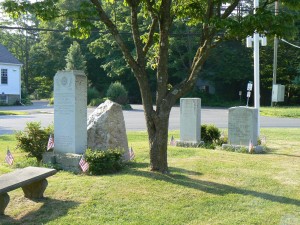 Monroe honors the wartime service of its veterans with several monuments near the town green.
Monroe honors the wartime service of its veterans with several monuments near the town green.
Four monuments at the intersection of Fan Hill Road and Route 111 honor veterans of the two world wars, Korea and Vietnam.
Monroe’s World War II monument, dedicated in 1953, is a granite marker with a fluted top. The monument’s north face bears the names of two residents lost in the conflict, and commemorates all residents who served.
A boulder honoring World War I veterans, dedicated in 1931, stands immediately behind the World War II monument. A plaque on the monument’s south face bears the dedication “In grateful recognition of the valor and devotion of the young men of this community who served in the world war for liberty and justice 1914-1919.” The plaque lists 24 names, and indicates that two were killed in the war.
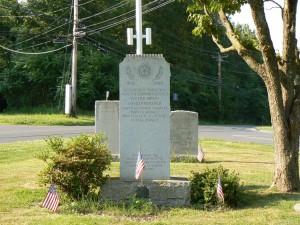 Just south of the World War I boulder, two monuments honor the service of Korean and Vietnam war veterans. The 1984 Vietnam memorial lists one resident lost in the conflict, and the 1985 Korean War memorial lists one resident who was killed and two who were wounded.
Just south of the World War I boulder, two monuments honor the service of Korean and Vietnam war veterans. The 1984 Vietnam memorial lists one resident lost in the conflict, and the 1985 Korean War memorial lists one resident who was killed and two who were wounded.
A short distance away, a granite flagpole base in front of Monroe’s municipal center further honors the town’s veterans. The monument’s left wing bears a dedication reading, “To all of those veterans from the town of Monroe who served their country: Honor. Hope. Remembrance. Gratitude. Peace and eternal rest.”
The monument’s right wing lists the nation’s wars and honors those who have made the supreme sacrifice, including one resident lost in the current Iraq conflict.
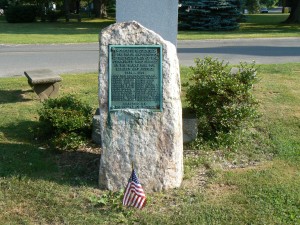 On the south side of the Monroe green, a 2008 monument commemorates the 1781 encampment of French cavalry forces commanded by the duc de Lauzunon.
On the south side of the Monroe green, a 2008 monument commemorates the 1781 encampment of French cavalry forces commanded by the duc de Lauzunon.
Tags: Monroe
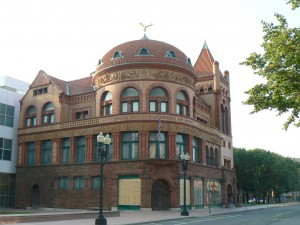 The tornado that struck the greater Bridgeport area Thursday afternoon caused serious damage to the Barnum Museum’s building and collections.
The tornado that struck the greater Bridgeport area Thursday afternoon caused serious damage to the Barnum Museum’s building and collections.
Two large windows near the museum’s Main Street entrance broke, allowing wind and water into the building.
The museum is seeking contributions to help with the restoration effort. More information and a PayPal link are available at the Barnum Museum’s website.
The museum, itself an historic landmark, opened in 1893 as a museum financed by P.T. Barnum that was devoted to science and history. The city of Bridgeport assumed ownership in the mid-1930s and operated the museum until 1943, when the building was renovated to house municipal offices.
Tags: Bridgeport
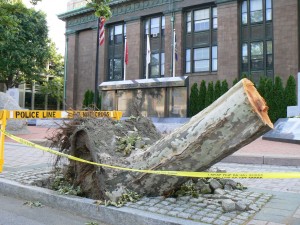 On Thursday afternoon, a tornado struck Bridgeport and surrounding towns. Based on a quick tour Saturday morning, the city’s downtown war memorials escaped storm damage.
On Thursday afternoon, a tornado struck Bridgeport and surrounding towns. Based on a quick tour Saturday morning, the city’s downtown war memorials escaped storm damage.
In downtown Bridgeport, the war memorials outside McLevy Hall appeared fine. A large tree was uprooted near the corner of Broad and State streets, and several trees were damaged at the City Hall annex on the other side of Broad Street.
The nearby Barnum Museum suffered damage to its building and collection during the tornado strike.
At Bridgeport’s Seaside Park, the 1876 Soldiers’ and Sailors’ Monument escaped damage, as did the cannon that commemorates the Spanish-American War and fountain that honors ASPCA founder Henry Bergh. We didn’t get to the area housing the Elias Howe statue, but we’re assuming it’s also OK.
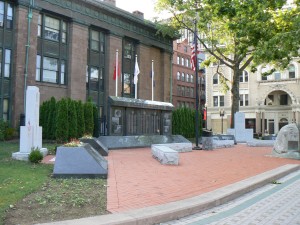 Overall, the tornado damaged a number of buildings and cars in Bridgeport, and downed trees and broken limbs are a sadly common sight as you drive around. Thankfully, no serious injuries were reported during the storm.
Overall, the tornado damaged a number of buildings and cars in Bridgeport, and downed trees and broken limbs are a sadly common sight as you drive around. Thankfully, no serious injuries were reported during the storm.
Tags: Bridgeport
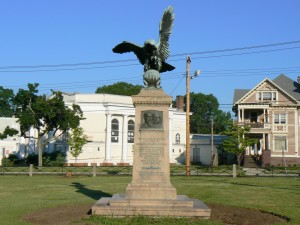 New Haven honors shipping and railroad investor Cornelius Scranton Bushnell, best known for his contributions to Civil War ironclads, with a monument in Monitor Square.
New Haven honors shipping and railroad investor Cornelius Scranton Bushnell, best known for his contributions to Civil War ironclads, with a monument in Monitor Square.
The 1906 monument near the intersection of Chapel Street and Derby Avenue honors Bushnell, a Madison native who operated a marine supply business, served as president of the New Haven and New London railroad, and opened a Fair Haven shipyard.
During the Civil War, Bushnell’s political and naval connections were instrumental in the development of the USS Monitor, the first Union ironclad warship. Bushnell was one of three private owners of the vessel during its first battle, after which the U.S. government agreed to purchase the ship and use its design for additional ironclads.
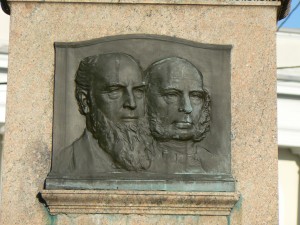 The monument’s east face bears a bronze portrait of Bushnell (on your left) and John Ericsson, the Swedish engineers and inventor who designed the Monitor. (Ericsson is honored with a monument in Washington, D.C.)
The monument’s east face bears a bronze portrait of Bushnell (on your left) and John Ericsson, the Swedish engineers and inventor who designed the Monitor. (Ericsson is honored with a monument in Washington, D.C.)
A dedication reads, “This memorial is erected in honor of Cornelius Scranton Bushnell, a citizen of New Haven to whose faith, persistence and patriotism the country is indebted for the construction of the Monitor from plans by John Ericsson. The Monitor defeated the Merrimac March 9th 1862.”
The monument is topped with large eagle standing on a sphere that bears the United States shield. The sphere is supported by four fish.
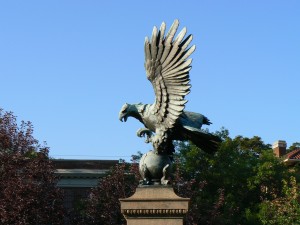 The monument was produced by sculptor Herbert Adams, whose other works include bronze doors at the Library of Congress, tablets at the Massachusetts State House and a number of other statues.
The monument was produced by sculptor Herbert Adams, whose other works include bronze doors at the Library of Congress, tablets at the Massachusetts State House and a number of other statues.
After the war, Bushnell was an investor and executive with the Union-Pacific railroad. He died in New York in 1896 and is buried in New Haven’s Evergreen Cemetery.
Tags: New Haven
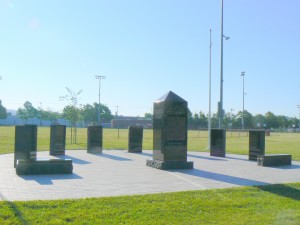 Connecticut’s African American Civil War veterans are honored with a 2008 monument in a New Haven park.
Connecticut’s African American Civil War veterans are honored with a 2008 monument in a New Haven park.
Descendants of the Connecticut 29th Colored Regiment, Connecticut Volunteer Infantry, dedicated the monument in New Haven’s Crisculo Park.
The 900 soldiers who fought with the regiment are honored with a large, polished black granite monument. Eight smaller monuments, listing members of the regiment, are arranged in an arc ranging from the north to the south. The smaller monuments also list the towns — from Avon to Woodstock — from which members joined.
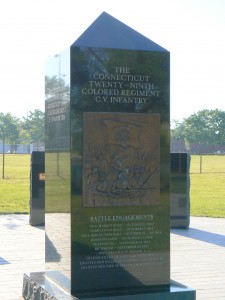 On the large monument’s west face, a bronze plaque depicts soldiers carrying the United States flag and the unit’s colors while others stand by with rifles. Below the plaque, the unit’s six engagements are listed.
On the large monument’s west face, a bronze plaque depicts soldiers carrying the United States flag and the unit’s colors while others stand by with rifles. Below the plaque, the unit’s six engagements are listed.
The west face also lists the 45 officers and enlisted men killed or mortally wounded, and the 152 men who died from disease or accident.
The south face is inscribed with a detailed history of the unit, which rallied on the site of today’s Crisculo Park (known as Grapevine Point at the time) and departed for the war in March of 1864.
The east face has an illustration depicting two soldiers, and the north face lists the 2008 dedication by the regiment’s descendents.
The monument was created by sculptor Ed Hamilton, who was also responsible for the Amistad memorial near New Haven’s City Hall.
Members of the CT 29th regiment from the greater Danbury area are honored with a 2007 monument in the city’s Wooster Cemetery.
 More information about the regiment, and photos from the New Haven monument’s 2008 dedication ceremony, can be seen at the CT 29th Web site.
More information about the regiment, and photos from the New Haven monument’s 2008 dedication ceremony, can be seen at the CT 29th Web site.
Tags: New Haven
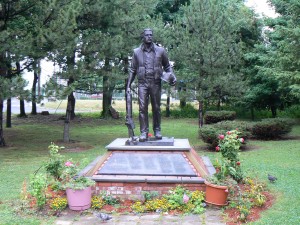 Two monuments honor the 28 workers killed in a 1987 construction accident at the L’Ambiance Plaza apartment complex in Bridgeport.
Two monuments honor the 28 workers killed in a 1987 construction accident at the L’Ambiance Plaza apartment complex in Bridgeport.
At the Washington Avenue accident site, a seven-foot statue of a construction worker honors the 28 workers killed, and the 22 injured, when the L’Ambiance Plaza building collapsed halfway through construction on April 23, 1987.
The names of the accident victims are listed on a dedication plaque on the monument’s base.
An 81-unit apartment building was built on the site in 1992, and the memorial to the L’Ambiance Plaza was dedicated a year later. The statue was created by Old Lyme artist Norman Legassie.
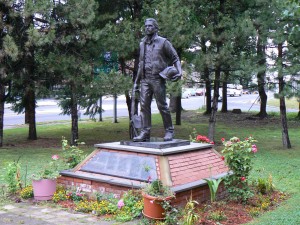 The L’Ambiance Plaza workers, and volunteers who participated in a 10-day rescue and recovery effort, are also honored with a monument about a third of a mile away in City Hall Park.
The L’Ambiance Plaza workers, and volunteers who participated in a 10-day rescue and recovery effort, are also honored with a monument about a third of a mile away in City Hall Park.
A bronze plaque lists the workers killed in the accident, and four helmets sit at the monument’s base. A granite marker, added in June of 2010, honors one of the rescue workers.
The L’Ambiance Plaza tragedy attracted international attention. At the time of its collapse, the complex was being built with the “lift-slab” construction method, in which concrete floor slabs were poured on the ground and raised into position.
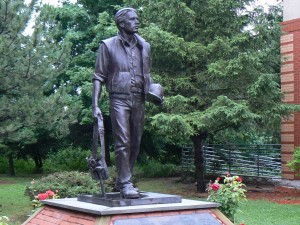 After the L’Ambiance Plaza collapse, lift-slab construction fell out of favor and has not been used since.
After the L’Ambiance Plaza collapse, lift-slab construction fell out of favor and has not been used since.
Tags: Bridgeport
